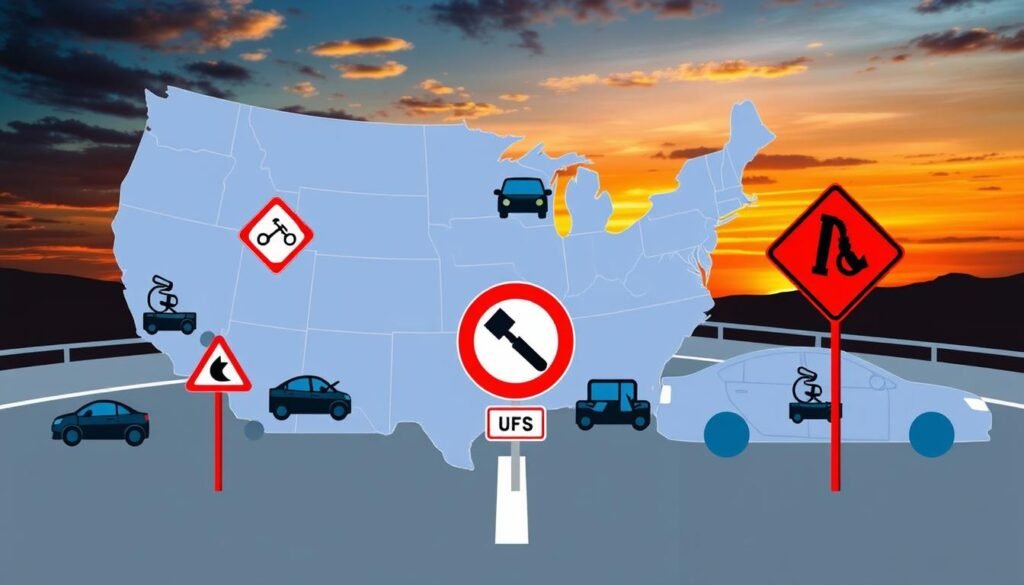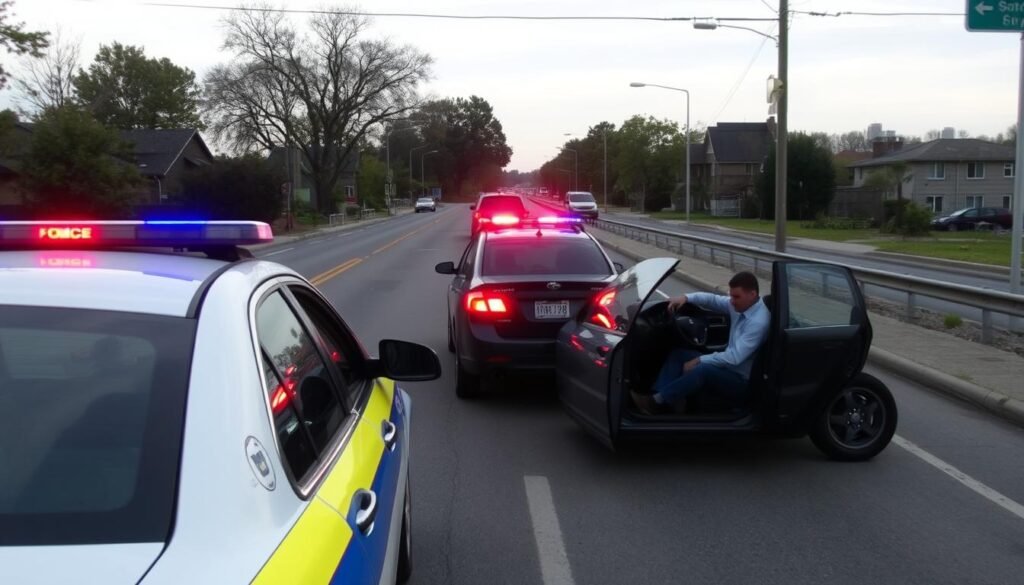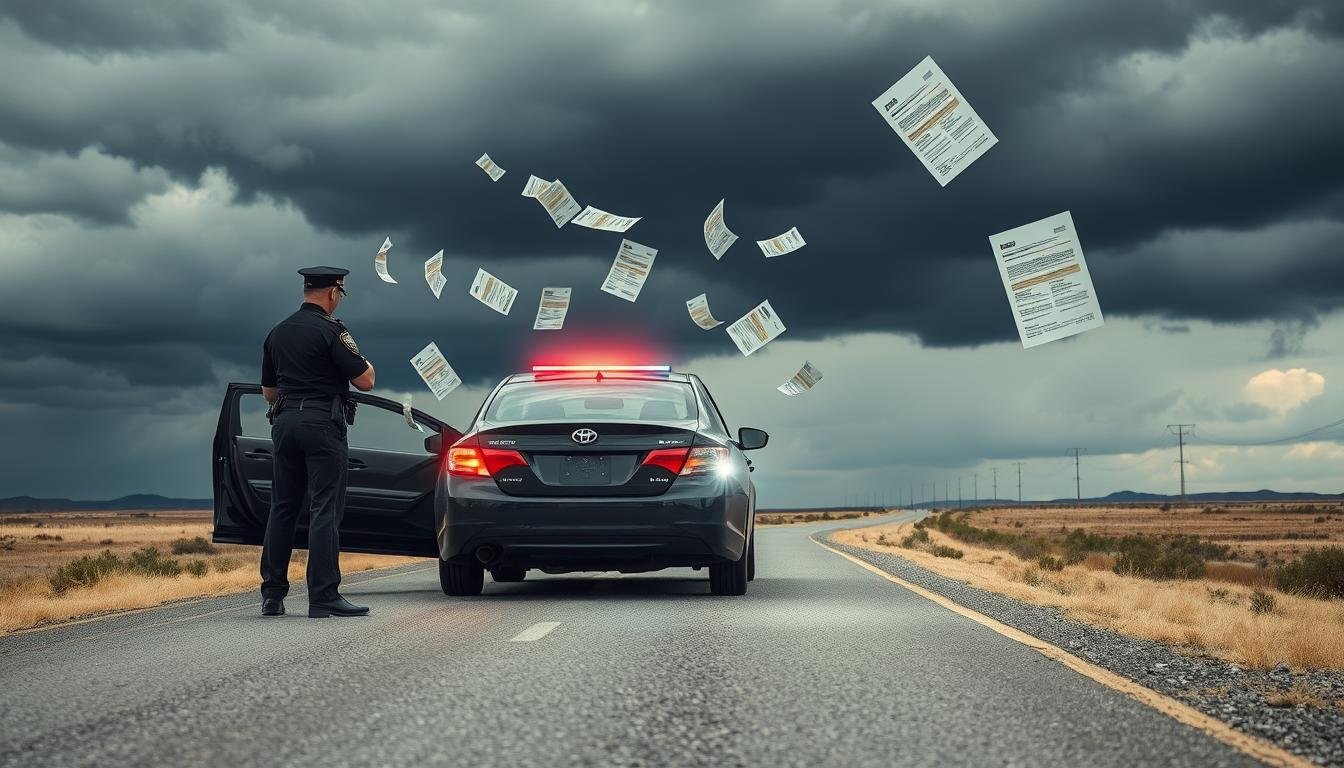Imagine seeing flashing lights in your rearview mirror. The officer then asks for your car insurance. What happens if you don’t have it? Driving without insurance can lead to big fines, losing your license, and even jail time. It’s important to know the laws and penalties in your state to avoid these bad outcomes.
Key Takeaways
- Driving without insurance is illegal almost everywhere in the U.S. It can lead to fines, losing your license, and having your car taken away.
- The fines for not having insurance vary by state. First-time offenders might pay between $100 and $5,000.
- Not having insurance can also make your insurance costs go up later. You might get a court summons and have to file an SR-22 form to get your license back.
- If you’re in an accident without insurance, you could owe a lot of money for damage and medical bills. This could cost hundreds of thousands of dollars.
- Having the right car insurance is key to avoid legal trouble and financial problems while driving.
Driving Without Insurance: Legal Requirements
In the United States, all states need drivers to have car insurance. This is true, except for New Hampshire. Each state has its own rules for insurance. Most states say you must have bodily injury and property damage coverage. Some states also want you to have uninsured/underinsured motorist protection, personal injury protection, or medical payments coverage.
State Laws and Minimum Coverage
In New York, all drivers must have auto insurance. You need to have:
- $25,000 per person for bodily injury liability
- $50,000 per accident for bodily injury liability
- $10,000 per accident for property damage liability
If you drive without insurance in New York, you could get fined up to $1,500 per incident. You might also get a surcharge of at least $500. And, you could even get up to 80 days of imprisonment. If you keep breaking the law, you could lose your license or registration.
| Coverage Type | Minimum Requirement in New York |
|---|---|
| Bodily Injury Liability | $25,000 per person, $50,000 per accident |
| Property Damage Liability | $10,000 per accident |
| Uninsured/Underinsured Motorist Bodily Injury | $25,000 per person, $50,000 per accident |
If you don’t have the legal minimums, even if you haven’t had an accident, you could get in trouble in New York. It’s important to get and keep the right liability coverage. This helps you avoid big financial and legal problems.

What happens if you get pulled over without insurance
Getting pulled over without insurance can lead to big trouble. You might face fines from $50 to $5,000. Your driver’s license and vehicle registration could also be taken away.
Your car might even get towed. You’ll have to pay to get it back.
You might also have to file an SR-22 form. This shows you have the right car insurance. It can make your insurance costs go up for a long time.
- Fines for driving uninsured can range from $50 to $5,000, depending on your state and whether it’s a repeat offense.
- Your driver’s license and vehicle registration may be suspended if you’re caught driving without insurance.
- Your vehicle could be impounded, requiring you to pay towing and storage fees to retrieve it.
- You may be required to file an SR-22 form, which can increase your insurance costs for years.
Getting caught driving without insurance can be a big financial hit. It’s important to keep your car insured. This way, you avoid big fines and keep everyone safe on the road.

“Driving without insurance is a serious offense that can have long-lasting consequences. It’s simply not worth the risk.”
Remember, the rules for driving without insurance change from state to state. Make sure you know what’s needed in your area. This way, you won’t get caught off guard during a traffic stop.
Consequences of an Uninsured Accident
Driving without insurance can lead to big problems if you cause an at-fault accident. You might face penalties for not having coverage. You could also be asked to pay for the damages and medical expenses of the other driver. This could cost you a lot of money, which you’d have to pay yourself.
Financial Liability and Legal Repercussions
If you crash while driving without insurance, the other driver might take you to court. This could lead to more financial and legal problems. You could face lawsuits and a bad mark on your driving record. The costs from an uninsured accident can be huge, so having insurance is very important.
The Centers for Disease Control and Prevention say a hospital stay after a car crash costs over $56,000 on average. Without insurance, you’d have to pay for these medical expenses. You’d also have to pay for any damage to property or other costs from the accident.
- Ohio law requires at least $25,000 in coverage for one person’s injuries, $50,000 for two or more people, and $25,000 for property damage.
- If caught driving without insurance in Ohio, you could face fines, losing your license plate, having your license suspended, and your car taken or sold.
- A first time without insurance in Ohio can cost you $100, with more fines for future offenses.
The financial and legal effects of driving without insurance can be devastating. It’s key to have the right coverage to protect yourself and others if an accident happens.
Obtaining Insurance After a Lapse
Drivers who have had a gap in their auto insurance face big challenges. They are seen as higher-risk by insurance companies. This can make their insurance costs much higher. Sometimes, they must file an SR-22 form, which adds to the cost.
A gap in insurance can hurt a driver’s record for a long time. It makes getting insurance later harder and more expensive. A short gap can cause a small increase in premiums. But a longer gap can lead to a nearly 50% increase.
Also, there are financial penalties for driving without insurance that start after 30 days.
| Lapse Duration | Premium Increase |
|---|---|
| Less than 30 days | Less than 10% |
| 30 to 60 days | Nearly 50% |
To fix their driving record and get cheaper insurance, drivers should keep their insurance active. This shows they are responsible drivers. It can lead to lower insurance rates over time.
“A lapse in car insurance coverage can stay on record from six months to three years, with the duration dependent on the length of the lapse and the insurer’s policies.”
Drivers should know how a lapse affects them and act fast to fix it. This way, they can protect their wallet and follow the law.

Alternatives to Traditional Insurance
Most states say you must have auto insurance. But, some states let you drive without it by using other ways. In New Hampshire, you can show you can pay for accidents by posting a bond or self-insuring. But, these ways are usually more expensive than regular insurance.
Self-Insurance and Surety Bonds
In Ohio, you need $30,000 to show you can pay for accidents with surety bonds or cash. Arizona wants $40,000 from those who choose bonds over regular insurance. These options let you drive without regular insurance, but they cost a lot upfront.
Other Methods to Drive Without Insurance
- In some states, like New Hampshire, you can show you’re responsible with self-insurance or surety bonds instead of regular insurance.
- In Georgia, the fine for driving without insurance is $25. In Hawaii, Massachusetts, New Jersey, North Dakota, and West Virginia, the fine can go up to $5,000.
- California fines you $100 to $250 (plus more) for driving without insurance the first time. Michigan can even send you to jail for a year.
These alternatives might let you drive without regular insurance, but they’re risky. They can cost you a lot and have serious legal problems. Think carefully before choosing these options.
| State | Minimum Financial Responsibility | Fines for Driving Without Insurance |
|---|---|---|
| Ohio | $30,000 | N/A |
| Arizona | $40,000 | N/A |
| Georgia | N/A | $25 minimum |
| Hawaii, Massachusetts, New Jersey, North Dakota, West Virginia | N/A | Up to $5,000 maximum |
| California | N/A | $100 to $250 (plus penalty assessments) for first offense |
| Michigan | N/A | Up to 1 year in prison |
Conclusion
Auto insurance is very important. Not having it can lead to big legal and money problems. If you don’t have enough insurance, you could face fines, lose your license, have your car taken away, or even go to jail.
Being in an accident without insurance means you could owe a lot of money for repairs and medical bills. These costs can add up fast, leaving you with a big bill. It’s best to get the right auto insurance to avoid these problems.
You can make sure you have enough insurance. Start by learning what your state requires. Then, look at different insurance companies to find a good deal. You might even find special insurance options that work for you.
Choosing the right auto insurance helps keep you and others safe. It also keeps you from facing big legal and money troubles from driving without it.
FAQ
What happens if you get pulled over without insurance?
If you’re pulled over without insurance, you could face fines, license suspension, and even a court summons. The fines can be from to ,000. You might also need to file an SR-22 form, which can make insurance more expensive.
What are the legal requirements for driving without insurance?
Most states, except New Hampshire, say you must have car insurance to drive. Each state has its own rules, but you usually need liability coverage for injuries and damage. Some states also want you to have extra coverage like uninsured motorist protection.
What are the consequences of getting into an accident while uninsured?
If you’re in an accident without insurance, you could be fully or partly to blame. This means you might have to pay for the other person’s damage and medical bills. They or their insurance might also take you to court, adding more trouble.
How does driving without insurance impact your ability to obtain coverage in the future?
If you don’t have insurance, getting it later will be hard. Companies will see you as a higher risk, so you’ll pay more. You might also need an SR-22 form, which costs more. This can also hurt your driving record, making insurance even harder to get.
Are there any alternatives to traditional auto insurance?
Some states let drivers use other ways to show they can pay for accidents, like a bond or self-insurance. But, these options are usually more expensive than regular insurance. So, they’re not a good choice for most people.
